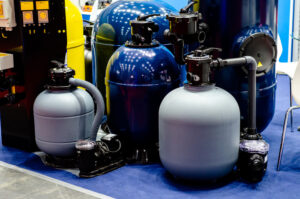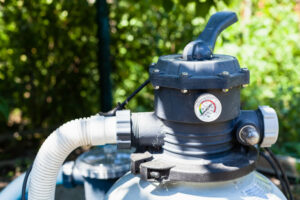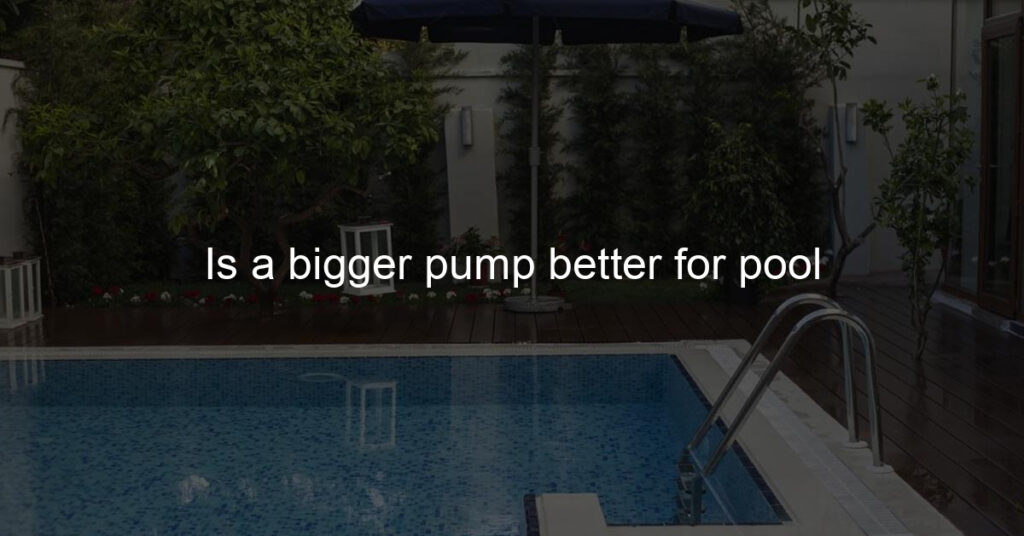Is A Bigger Pump Better For Pool
Attention pool owners and enthusiasts!
Have you ever wondered if bigger is truly better when it comes to pool pumps?
Get ready to dive into the world of pool maintenance as we unravel the mystery behind the size of your pump. In this article, we’ll explore the benefits and considerations of a larger pump for your pool, discussing its impact on water circulation, filtration efficiency, and energy consumption.
So, before you make any upgrades or replacements, let’s uncover the truth about whether a bigger pump can make a splash in your pool maintenance routine.
Introduction: Understanding the role of pool pumps
Pool pumps play a crucial role in maintaining the cleanliness, clarity, and overall health of your swimming pool. They are responsible for circulating the water, facilitating proper filtration, and ensuring that the pool chemicals are evenly distributed.
Without a functioning pump, the water in your pool can become stagnant, leading to a buildup of debris, algae growth, and an imbalance in water chemistry.
Understanding the importance of pool pumps sets the foundation for exploring whether a bigger pump is better for your pool.
What is a pool pump and how does it work?
A pool pump is a mechanical device that pulls water from the pool, passes it through a filter to remove impurities, and then returns the clean, filtered water back into the pool.
The pump consists of an electric motor and an impeller. When the motor is turned on, it spins the impeller, creating a centrifugal force that pulls water through the pump’s inlet and pushes it out through the outlet.
This continuous circulation process helps prevent water stagnation and allows for proper filtration and distribution of chemicals throughout the pool.
The importance of proper water circulation in a pool

Proper water circulation is vital for maintaining a healthy and inviting swimming pool. Effective circulation helps distribute chemicals evenly, preventing localized imbalances that can lead to issues such as algae growth or chemical overdosing.
It also helps prevent the formation of dead zones where debris can accumulate.
Furthermore, proper circulation enhances the efficiency of the pool’s filtration system, allowing it to capture and remove particles, dirt, and contaminants more effectively. Adequate water circulation promotes a clean, clear, and balanced pool environment for swimmers to enjoy.
Assessing the benefits of a larger pump
One of the main advantages associated with a larger pool pump is its ability to achieve a higher water turnover rate. A larger pump typically has a more powerful motor and a larger impeller, allowing it to move a greater volume of water in a given time.
This increased flow rate can help improve water circulation, ensuring that all areas of the pool receive adequate filtration and chemical distribution.
Additionally, a higher turnover rate can enhance the pool’s overall water quality by reducing the chances of debris buildup and algae growth.
Examining the impact of pump size on water turnover rate

The size of a pool pump has a direct impact on the water turnover rate, which refers to the amount of time it takes for the pump to circulate the entire pool’s volume. A larger pump can achieve a faster turnover rate since it can move more water per minute.
The recommended turnover rate for a pool is typically around 6 to 8 hours, meaning the entire pool volume should pass through the pump and filtration system within that time frame.
By selecting a larger pump, you can potentially achieve a shorter turnover period, which can contribute to improved water quality and enhanced pool maintenance.
Ensuring effective filtration with a bigger pump
Filtration is a critical component of pool maintenance, as it removes debris, small particles, and contaminants from the water. A larger pump can positively impact the effectiveness of filtration by enhancing the flow rate and increasing the amount of water passing through the filter system.
With a higher flow rate, the filter can capture and retain more debris, providing cleaner water for swimmers.
However, it is important to consider the compatibility between the pump and the filter, ensuring they are appropriately matched to achieve optimal filtration efficiency.
Addressing concerns about energy consumption
While a larger pump can offer benefits in terms of water circulation and filtration, it is important to consider its potential impact on energy consumption.
Larger pumps generally have more powerful motors, which can consume more electricity. This can result in higher energy costs over time. Additionally, running a larger pump continuously may not be necessary for all pools, especially smaller or less frequently used ones.
It is essential to strike a balance between pump size, energy efficiency, and the specific needs of your pool to avoid unnecessary energy consumption.
Exploring the relationship between pump size and pool size

The size of your pool is a crucial factor to consider when determining the appropriate pump size. Larger pools typically require more powerful pumps to ensure proper water circulation and filtration.
A smaller pump may struggle to effectively circulate the water in a larger pool, leading to inadequate filtration and potential water quality issues. Conversely, installing an excessively large pump in a small pool can be inefficient and unnecessary, leading to higher energy costs without substantial benefits.
Assessing the size of your pool accurately is essential to choose a pump that aligns with its specific requirements.
Determining the ideal pump size for your specific pool
To determine the ideal pump size for your pool, several factors should be taken into account. These include the pool volume, the desired turnover rate, the length and complexity of plumbing lines, the presence of water features (such as waterfalls or fountains), and any specific filtration requirements.
Consulting with a pool professional or utilizing online calculators can help you determine the appropriate pump size based on these factors, ensuring that your pool receives adequate circulation and filtration without unnecessary energy consumption.
Considerations for pool owners with different types of pool systems
Different types of pool systems may have unique considerations when it comes to pump sizing.
For example, pools with attached spas or water features may require additional pump power to accommodate the increased flow rate needed for these features. Saltwater pools may benefit from larger pumps to help manage the higher salinity levels and prevent scale buildup.
In contrast, above-ground pools or smaller in-ground pools may have different pump size requirements based on their volume and intended usage.
Understanding the specific needs of your pool system is crucial in determining the optimal pump size.
Balancing pump power with noise levels
When considering a larger pool pump, it is important to be mindful of the potential increase in noise levels. Larger pumps often have more powerful motors, which can generate more noise during operation.
If noise is a concern, you may need to consider alternative solutions such as installing noise-reducing equipment or selecting a pump model specifically designed for quieter operation.
Achieving a balance between pump power and noise levels ensures a comfortable and enjoyable pool experience for swimmers and neighboring areas.
The potential drawbacks of a larger pump

While a larger pump can offer benefits in terms of water circulation and filtration, there are potential drawbacks to consider. One significant drawback is the increased energy consumption, which can lead to higher utility bills.
Additionally, larger pumps may require more extensive plumbing modifications during installation, leading to higher upfront costs.
Moreover, if a larger pump is selected without proper consideration of the pool size and specific needs, it can result in excessive flow rates, causing turbulence, inefficient filtration, and potential damage to the pool’s plumbing system.
It is essential to carefully evaluate the pros and cons before opting for a larger pump.
Maintenance considerations for bigger pool pumps
Maintaining a larger pool pump may require additional attention and maintenance efforts. The increased flow rate and power can place more strain on the pump’s components, necessitating regular inspections and cleaning to prevent clogs and debris buildup.
Proper lubrication, motor maintenance, and ensuring adequate ventilation are essential for prolonging the pump’s lifespan.
Following the manufacturer’s guidelines and scheduling routine maintenance checks will help maximize the performance and longevity of a larger pool pump.
| Pump Size (Horsepower) | Flow Rate (Gallons per Minute) | Energy Consumption (Watts) | Recommended Pool Size |
| 1 HP | 60 GPM | 1200 W | Up to 20,000 gallons |
| 1.5 HP | 80 GPM | 1500 W | 20,000 – 30,000 gallons |
| 2 HP | 100 GPM | 1800 W | 30,000 – 40,000 gallons |
| 2.5 HP | 120 GPM | 2200 W | Over 40,000 gallons |
This table provides a comparison of pump sizes ranging from 1 HP to 2.5 HP.
It includes important parameters such as the flow rate (measured in gallons per minute), energy consumption (in watts), and the recommended pool size for each pump.
This comparison can serve as a reference to help you assess which pump size aligns best with your specific pool requirements.
Exploring alternative solutions for improved pool performance
While a bigger pump is one option to enhance pool performance, it is not the only solution. Depending on your specific pool needs, there may be alternative strategies to improve circulation and filtration.
These include optimizing the plumbing system, utilizing additional or upgraded filters, or incorporating supplemental circulation devices such as water jets or booster pumps.
Exploring these alternatives with a pool professional can help identify the most suitable options for your pool, considering factors such as cost-effectiveness, energy efficiency, and maintenance requirements.
| Solution | Description | Benefits |
| Variable Speed Pump | A pump with adjustable speed settings, allows you to customize flow rates based on pool needs. | Energy-efficient, lower operating costs |
| Cartridge Filter | A type of pool filter that uses replaceable cartridges to capture debris and particles from the water. | Low maintenance, superior filtration |
| Water Jet Circulation System | Additional water jets are installed in the pool to enhance circulation and promote better water movement. | Increased water turnover, improved water clarity |
| Booster Pump for Water Features | A supplementary pump dedicated to powering water features such as waterfalls, fountains, or spa jets. | Efficient operation of water features, enhanced aesthetics |
| Ozone or UV Sanitization Systems | Alternative sanitation methods that use ozone or ultraviolet light to eliminate bacteria and reduce chemical dependency. | Reduced chemical usage, and improved water quality |
This table presents four alternative solutions for improved pool performance.
Each solution is briefly described, highlighting its unique benefits. You can consider these alternatives based on your specific needs, such as energy efficiency, water clarity, maintenance requirements, or the desire to reduce chemical usage.
Exploring these options can help enhance the overall performance and enjoyment of the pool.
Conclusion: Finding the right pump size for optimal pool maintenance
In conclusion, determining whether a bigger pump is better for your pool requires careful consideration of various factors.
While a larger pump can provide benefits such as improved water circulation and filtration, it is crucial to assess the specific needs of your pool, taking into account factors like pool size, desired turnover rate, energy consumption, and maintenance requirements.
Striking a balance between pump size, efficiency, and cost-effectiveness will help ensure optimal pool maintenance, providing clean, clear, and inviting water for a refreshing swimming experience.
By finding the optimal balance between pump size, efficiency, and cost-effectiveness, you can ensure a clean and enjoyable swimming experience.














